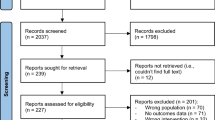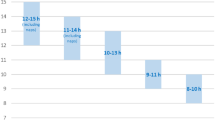Abstract
Purpose of Review
Headache disorders in children and adolescents are common. Among the different headache disorders, migraine and tension headache are highly prevalent and often debilitating. Pharmacological treatments for pediatric patients are often not approved or effective. Practice guidelines for prevention of pediatric headache and migraine are now incorporating information and recommendations regarding non-pharmacologic therapeutic options. Understanding the mechanism of action, safety, and efficacy of the non-pharmacologic as well as mindful-based therapeutic alternatives currently available for the management and treatment of headache and migraine may allow additional treatment alternatives for children with these conditions.
Recent Findings
Studies have been published looking at non-pharmacologic treatments, and mindful-based approaches, namely relaxation, mindfulness meditation, yoga, and hypnosis as options for the treatment of headache and migraine, although there are few that examine these in children and adolescents. Several recent studies that have relevance to the care of children with headache and migraine are reviewed.
Summary
Non-pharmacologic and mindful-based approaches for the prevention and treatment of headache and migraine in children show safety and efficacy data that is promising. Consider incorporating these multi-modal approaches into the therapeutic management strategies for the child or adolescent with headache and migraine. Additional prospective studies and/or randomized-controlled trials are necessary to further assess the efficacy and cost-effectiveness of these methods.
Similar content being viewed by others
References
Papers of particular interest, published recently, have been highlighted as: • Of importance •• Of major importance
Bille B. A 40-year follow-up of school children with migraine. Cephalalgia. 1997;17(4):488–91. Discussion 487. https://doi.org/10.1046/j.1468-2982.1997.1704488. x.
Victor TW, Hu X, Campbell JC, Buse DC, Lipton RB. Migraine prevalence by age and sex in the United States: a life-span study. Cephalalgia. 2010;30(9):1065–72. https://doi.org/10.1177/0333102409355601.
Kedia S, Ginde AA, Grubenhoff JA, Kempe A, Hershey AD, Powers SW. Monthly variation of United States pediatric headache emergency department visits. Cephalalgia. 2014;34(6):473–8. https://doi.org/10.1177/0333102413515346.
••Oskoui M, Pringsheim T, Billinghurst L, Potrebic S, Gersz EM, Gloss D, Holler-Managan Y, Leininger E, Licking N, Mack K, Powers SW, Sowell M, Victorio MC, Yonker M, Zanitsch H, Hershey AD. Practice guideline update summary: pharmacologic treatment for pediatric migraine prevention: report of the Guideline Development, Dissemination, and Implementation Subcommittee of the American Academy of Neurology and the American Headache Society. Neurology. 2019;93(11):500–509. https://doi.org/10.1212/WNL.0000000000008105. This is a practice guideline for treatment of Pediatric Headache supported by the American Academy of Neurology and the American Headache Society.
••Ailani J, Burch R, Robbins M. The American Headache Society Consensus Statement: update on integrating new migraine treatments into clinical practice. Headache. 2021. https://doi.org/10.1111/head.14153. This is a recently published practice guideline for treatment of migraine supported by the American Headache Society.
•Jong MC, Boers I, van Wietmarschen HA, Tromp E, Busari JO, Wennekes R, Snoeck I, Bekhof J, Vlieger AM. Hypnotherapy or transcendental meditation versus progressive muscle relaxation exercises in the treatment of children with primary headaches: a multi-centre, pragmatic, randomised clinical study. Eur J Pediatr. 2019;178(2):147–154. https://doi.org/10.1007/s00431-018-3270-3. This is a randomized controlled study that showed effectiveness of two mind-body techniques, meditation, and hypnotherapy for pediatric headaches, when studies are typically lacking in this area.
Faedda N, Natalucci G, Baglioni V, Giannotti F, Cerutti R, Guidetti V. Behavioral therapies in headache: focus on mindfulness and cognitive behavioral therapy in children and adolescents. Expert Rev Neurother. 2019;19(12):1219–28. https://doi.org/10.1080/14737175.2019.1654859.
Kamath A, Shetty J. Are alternative and complementary therapies effective for tension-type headaches in children? Arch Dis Child. 2020;105(8):802–4. https://doi.org/10.1136/archdischild-2020-319303.
Wells RE, Burch R, Paulsen RH, Wayne PM, Houle TT, Loder E. Meditation for migraines: a pilot randomized controlled trial. Headache. 2014;54(9):1484–95. https://doi.org/10.1111/head.12420.
Wojcikowski K, Vigar VJ, Oliver CJ. New Concepts of Chronic Pain and the Potential Role of Complementary Therapies. Altern Ther Health Med. 2020;26(S1):18–31.
Gotink RA, Chu P, Busschbach JJ, Benson H, Fricchione GL, Hunink MG. Standardized mindfulness-based interventions in healthcare: an overview of systematic reviews and meta-analyses of RCTs. PLoS One. 2015;10(4): e0124344. https://doi.org/10.1371/journal.pone.0124344.
Wells RE, O’Connell N, Pierce CR, Estave P, Penzien DB, Loder E, Zeidan F, Houle TT. Effectiveness of mindfulness meditation vs headache education for adults with migraine: a randomized clinical trial. JAMA Intern Med. 2021;181(3):317–28. https://doi.org/10.1001/jamainternmed.2020.7090.
Lipton RB, Buse DC, Hall CB, Tennen H, Defreitas TA, Borkowski TM, Grosberg BM, Haut SR. Reduction in perceived stress as a migraine trigger: testing the “let-down headache” hypothesis. Neurology. 2014;82(16):1395–401. https://doi.org/10.1212/WNL.0000000000000332.
Anheyer D, Leach MJ, Klose P, Dobos G, Cramer H. Mindfulness-based stress reduction for treating chronic headache: a systematic review and meta-analysis. Cephalalgia. 2019;39(4):544–55. https://doi.org/10.1177/0333102418781795.
Grazzi L, Sansone E, Raggi A, D’Amico D, De Giorgio A, Leonardi M, De Torres L, Salgado-García F, Andrasik F. Mindfulness and pharmacological prophylaxis after withdrawal from medication overuse in patients with chronic migraine: an effectiveness trial with a one-year follow-up. J Headache Pain. 2017;18(1):15. https://doi.org/10.1186/s10194-017-0728-z.
Gu Q, Hou JC, Fang XM. Mindfulness meditation for primary headache pain: a meta-analysis. Chin Med J (Engl). 2018;131(7):829–38. https://doi.org/10.4103/0366-6999.228242.
Bougea A, Spantideas N, Chrousos GP. Stress management for headaches in children and adolescents: a review and practical recommendations for health promotion programs and well-being. J Child Health Care. 2018;22(1):19–33. https://doi.org/10.1177/1367493517738123.
Waelde LC, Feinstein AB, Bhandari R, Griffin A, Yoon IA, Golianu B. A pilot study of mindfulness meditation for pediatric chronic pain. Children (Basel). 2017;4(5):32. https://doi.org/10.3390/children4050032.
Sansone E, Raggi A, Grignani E, Leonardi M, D’Amico D, Scaratti C, Grazzi L. Mindfulness meditation for chronic migraine in pediatric population: a pilot study. Neurol Sci. 2018;39(Suppl 1):111–3. https://doi.org/10.1007/s10072-018-3365-7.
Azam MA, Katz J, Mohabir V, Ritvo P. Individuals with tension and migraine headaches exhibit increased heart rate variability during post-stress mindfulness meditation practice but a decrease during a post-stress control condition — a randomized, controlled experiment. Int J Psychophysiol. 2016;110:66–74. https://doi.org/10.1016/j.ijpsycho.2016.10.011.
Latha D, Kaliappan KV. Efficacy of yoga therapy in the management of headaches. J Indian Psychol. 1992;10:41–7.
Sethi BB, Trivedi JK, Anand R. A comparative study of relative effectiveness of biofeedback and shavasana (yoga) in tension headache. Indian J Psychiatry. 1981;23:109–14.
Hainsworth KR, Salamon KS, Khan KA, Mascarenhas B, Davies WH, Weisman SJ. A pilot study of yoga for chronic headaches in youth: promise amidst challenges. Pain Manag Nurs. 2014;15(2):490–8. https://doi.org/10.1016/j.pmn.2012.12.002.
Sawni A, Breuner CC. Clinical hypnosis, an effective mind-body modality for adolescents with behavioral and physical complaints. Children (Basel). 2017;4(4):19. https://doi.org/10.3390/children4040019.
Flynn N. Effect of an online hypnosis intervention in reducing migraine symptoms: a randomized controlled trial. Int J Clin Exp Hypn. 2019;67(3):313–335. https://doi.org/10.1080/00207144.2019.1612674.
Flynn N. Systematic review of the effectiveness of hypnosis for the management of headache. Int J Clin Exp Hypn. 2018;66(4):343–352. https://doi.org/10.1080/00207144.2018.1494432.
Schramm SH, Moebus S, Lehmann N, Galli U, Obermann M, Bock E, Yoon MS, Diener HC, Katsarava Z. The association between stress and headache: a longitudinal population-based study. Cephalalgia. 2015;35(10):853–63. https://doi.org/10.1177/0333102414563087.
Author information
Authors and Affiliations
Corresponding author
Ethics declarations
Conflict of Interest
The authors declare no competing interests.
Human and Animal Rights
This article does not contain any studies with human or animal subjects performed by any of the authors.
Additional information
Publisher's Note
Springer Nature remains neutral with regard to jurisdictional claims in published maps and institutional affiliations.
This article is part of the Topical Collection on Psychological and Behavioral Aspects of Headache and Pain
Rights and permissions
About this article
Cite this article
Rastogi, R.G., Arnold, T.L., Borrero-Mejias, C. et al. Non-pharmacologic and Mindful-Based Approaches for Pediatric Headache Disorders: a Review. Curr Pain Headache Rep 25, 78 (2021). https://doi.org/10.1007/s11916-021-00993-w
Accepted:
Published:
DOI: https://doi.org/10.1007/s11916-021-00993-w




